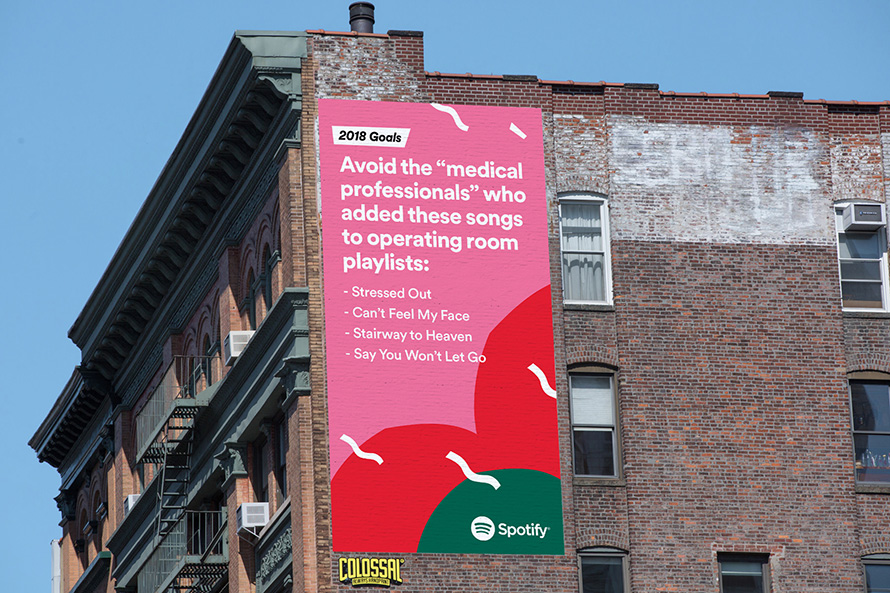I remember walking along the New York City High Line — a Queens railway turned scenic nature path through Manhattan — and looking up to see one of Spotify’s vibrantly colored billboards on the side of a nearby building.
It captured my attention. It made me laugh — not just because it was witty, but because it was relatable. As I took in the ad that reflected absurd and comical listening habits Spotify had observed from users over the year, it made me recant my own Spotify experience and reflect on what my own musical habits say about me.
The theme of Spotify’s ad campaign this year is “2018 Goals”, recognizing the ups and downs we’ve experienced in our country and across the globe this year and translating user data into clever headlines that humorously offer suggestions for embracing everything 2018 throws our way.
“This year, by looking at our own data and the external data, observing the world, there was just this level of fatigue,” shares Spotify CMO Seth Farbman in an interview with Adweek. “There was a level of real distraction in our lives, from over a year of constantly changing news — things we thought were usual and normal that were changing. Some of it comes from D.C. and London and elsewhere. Some of it comes from the natural disasters that really impacted people’s lives. It was like, you just couldn’t get a break.”
And so the “2018 Goals” campaign was born. “We decided, ‘Let’s look forward instead of back, and let’s inject optimism and humor where we can.’”
If you haven’t seen the ads, you can check them out here. I’ve included a few of my favorites below.
Spotify does a beautiful job here of allowing the data to speak for itself in this refreshingly direct and personal approach. Rather than making assumptions or grandiose claims about a general population, they use direct data examples and show individual listening habits, which in turn taps into the collective mood of our country and world as we’ve experienced the weight of tremendous political, cultural and natural forces this year.
“…the more concrete you can be, the easier it is to communicate. We take individual experiences, individual data points, and use them to represent a broader feeling,” Farbman explains. “…when you get very concrete, so you’re realizing this is a real person with real listening habits, real playlists, real playlist names, then it just cuts through the clutter.”
Spotify’s ability to collect massive amounts of user data gives vast insight into the collective and individual attitudes of its listeners and allows the company to create both shared and personalized, individual experiences for its users.
Beyond its out-of-home campaign, Spotify tracks individual users listening habits and uses that data to deliver a customized listening experience, including weekly recommendations of songs you might like based on your previous listening history. I can say in my own personal experience with Spotify that these recommendations have led me to discover some of my favorite bands and spurred me on to numerous concert-going experiences. In this way Spotify’s data-informed user experience not only aids listeners in their pursuit of new music, but helps new and upcoming artists get their name out there.
Spotify also delivers each user a personalized year-in-music wrap-up, a feature they titled “2017 Wrapped” this year. This individualized dashboard of your musical habits shows you what you listened to in 2017, what artists you helped make popular, what moods you were in during different periods of time, what genres you gravitated toward this year, your most played songs and artists, and more.
From a very direct, customized user experience to witty, data-driven, listener-centric outdoor ads, Spotify sets a precedent for using data-derived analytics to make listeners feel seen and heard on an individual level as well as unified as a collective whole.
At Elliance, our digital team uses real-time data as well. And although it is not used in the same direct manner seen in Spotify’s out-of-home ads, it is an essential part of our marketing process. It drives our strategic thinking, from content creation and optimization to keyword targeting and image selection, as we create successful campaigns that lift the voices this data represents. We utilize A/B testing with the ads we generate to give insight into which creative messaging and images connect with the audience. Our team also observes traffic patterns and engagement numbers to inform creative strategy for blog content and infographic creation to ensure we produce content that resonates with the target audience.
If you’re ready to take your business or institution to the next level, expand your reach and better serve your audience, you’ve come to the right place. Contact us today to learn about how we can elevate your brand and help you reach your business goals.




Comments